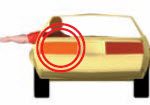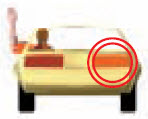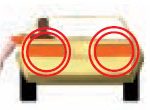Signaling
Always signal when turning left or right, changing lanes, slowing down, or stopping. Signaling lets other drivers, motorcyclists, bicyclists, and pedestrians know your intentions.
Signals may be given by hand-and-arm positions or using the vehicle’s signal lights. If bright sunlight makes the signal lights hard to see, also use hand-and-arm signals.
| LEFT TURN | RIGHT TURN | SLOW OR STOP |
 |
 |
 |
Motorcyclists often use hand signals to make themselves more visible. Bicyclists may give right turn signals with their right arm held straight out, pointing right.
Signal:
- During the last 100 feet before reaching the turning point (left or right turn).
- Before every lane change. Check your mirrors, look over your shoulder, and check your blind spot before changing lanes.
- At least 5 seconds before you change lanes on a freeway.
- Before pulling next to the curb or away from the curb.
- When you change directions.
- Even when you do not see other vehicles. A vehicle you do not see may suddenly appear and hit you.
- If you plan to turn beyond an intersection. Start signaling when you are in the intersection. If you signal too early, the other driver may think you plan to turn into the intersection and they may pull out in front of you. Remember to cancel your signal after turning.
Steering
Recommendations for steering control and hand positions differ from vehicle to vehicle based on the size, age, speed, and responsiveness of the vehicle. While there is no one correct hand position or way to steer, the National Highway Traffic Safety Administration (NHTSA) has provided some basic guidelines.
Hand Position
If you think of the steering wheel as the face of a clock, place your hands at 9 and 3 o’clock, or slightly lower at 8 and 4 o’clock. To reduce face, arm, and hand injuries in the case of a deployed air bag, you should grip the outside of the steering wheel, with your knuckles on the outside of the wheel, and your thumbs stretched along the rim.
Controlling the Vehicle
There is no one correct way to steer a vehicle safely, but here are a few steering methods recommended by NHTSA:
- Hand-to-Hand Steering–This steering method may also be called “push/pull” steering. Using this steering method, your hands do not cross over the face of the steering wheel, and therefore there is less chance of injury to your face, arms, or hands in the event of an air bag deploying. When using this method, start with your hands at 9 and 3 o’clock, or slightly lower at 8 and 4 o’clock. Depending on the direction you are turning, one hand will push the wheel up, and the opposite hand pulls down.
- Hand-Over-Hand Steering–This method of steering can be used when turning at low speeds, parking, or recovering from a skid. When using this method, start with your hands at 9 and 3 o’clock, or slightly lower at 8 and 4 o’clock. Depending on the direction you are turning, one hand will push the wheel up, while the other hand will let go, reach across the other arm, grasp the wheel, and pull up.
- One Hand Steering–NHTSA recommends using one-hand steering only when turning while backing, or operating vehicle controls that require removing a hand from the steering wheel. The only time that a 12 o’clock hand position is recommended is when backing a vehicle while turning, as the driver must turn in their seat to see the path of the vehicle. The placement of hands on the wheel at 9 and 3 o’clock, or slightly lower at 8 and 4 o’clock, is critical to vehicle balance.
Horn, Headlights, and Emergency Signals
Use Your Horn
- Only when necessary, to avoid collisions.
- To try to get “eye contact” with other drivers. You may tap your horn to alert another driver who might turn in front of you and cause a collision.
- On narrow mountain roads, where you cannot see at least 200 feet ahead of your vehicle.
Don’t Use Your Horn
- If a driver or bicyclist is moving slowly, and you want them to drive faster or get out of your way. The driver or bicyclist may not be able to safely go faster due to illness, being lost, intoxication, or mechanical problems with the vehicle.
- To alert other drivers that they made a mistake. Your honking may cause them to make more mistakes or become angry and retaliate.
- Because you may be angry or upset.
- To honk at pedestrians, bicyclists, or motorcyclists unless necessary to avoid a collision. Remember that your horn sounds much louder outside a vehicle.
Note: Honking your horn may startle other drivers. It is safer to slow down or stop instead of honking your horn.
Use Your Headlights
- If weather conditions require you to use your windshield wipers, you are required to turn on your low-beam headlights.
- Any time conditions (clouds, rain, snow, dust, smoke, fog, etc.) prevent you from seeing other vehicles.
- On small country or mountain roads, even on sunny days.
- In darkness and when visibility does not allow clear recognition of a person or vehicle from a distance of 1,000 feet.
- When the vehicle is operated from 30 minutes after sunset to 30 minutes before sunrise.
- When a regulatory (white) road sign is posted stating headlights must be on.
- To increase your vehicle’s visibility to others while driving – even on bright days and especially when the sun is low on the horizon.
Use Your Emergency Signals
If you can see a collision ahead, warn the drivers behind you by turning on your emergency flashers or tapping your brake pedal quickly 3 or 4 times. You can also use the hand signal when slowing and stopping.
Never stop on the road unless necessary for safety or to obey a law. If you need to stop, start braking early as a signal to the cars behind you. If your vehicle breaks down on the road, make sure that other drivers can see it. If you experience vehicle trouble and need to stop, follow these rules:
- Pull off the road away from all traffic, if possible.
- If you cannot get completely off the road, stop where people can see you and your vehicle from behind. Do not stop just over a hill or just around a curve.
- Turn on your emergency flashers if you are not moving. If your vehicle doesn’t have emergency flashers, turn signals may be used instead.
- If it is safe, lift the hood to signal an emergency.
- Give other drivers plenty of warning. Place emergency f lares or triangles 200–300 feet behind the vehicle. This allows other drivers time to change lanes, if necessary. Be very careful when using flares. They may cause fires, especially when used near flammable liquids.
- If you do not have emergency flares, follow the rules listed above and stay in your vehicle until help arrives. Be careful for your safety and stay off the road.
Text Messaging and Cell Phones
It is illegal to drive a motor vehicle while using a cell phone or an electronic wireless communication device to write, send, or read text messages, instant messages, and emails unless you are 18 years old or older and using a cell phone or an electronic wireless communications device designed and configured to allow voice and hands-free operation to dictate, send, or listen to text-based communications when operating a vehicle. Although hands-free devices are permitted (except for minors), drivers should minimize distractions to focus on safe driving practices.
- Call for help in emergencies only.
- If your cell phone rings, do not answer it. Let the call go to voicemail, if you have this feature.
- If you must make a call, pull safely off the road before making the call.
- Keep telephone conversations short or, if possible, have a passenger make the call.
- If you use your electronic wireless communications device:
- It must be mounted on the windshield, dashboard, or center console of the vehicle.
- It cannot hinder your view of the road.
- Use a single swipe or touch on the mounted electronic device.
Do not use your cell phone:
- During hazardous conditions.
- To engage in distracting conversations.
Note: Minors may not use a cell phone or an electronic wireless communications device except in certain emergencies (refer to the “Minors and Cell Phones” sectionfor additional information).